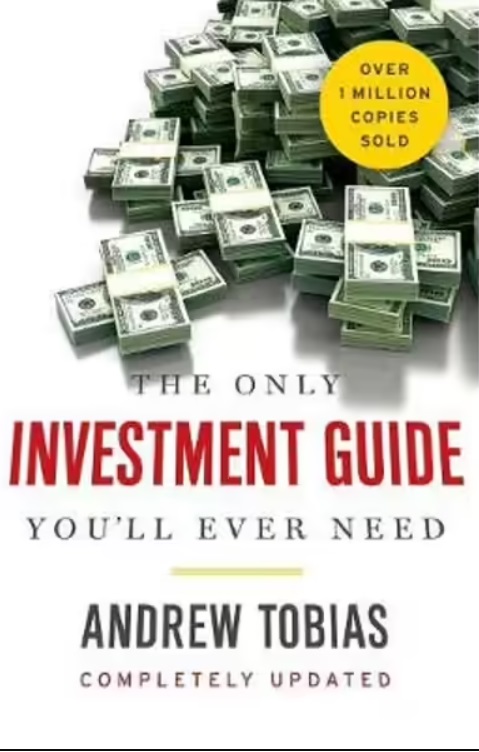About a week ago I was, once again, browsing through my bookshelves and happened to have an appetite for something simple, entertaining, and effective.
Written by Andrew Tobias, The Only Investment Guide You’ll Ever Need is one of the best investment books for beginners out there.
The book aims to keep things extremely simple, so you might want to read books like The Random Walk Down Wall Street by Burton Malkiel or Stocks for the Long Run by Jeremy J. Siegel for additional information.
So, while it truly can be the only investment guide you’ll ever need, it’s definitely not the only investment guide you should ever read.
Anyways, here are the 6 most important lessons from The Only Investment Guide You’ll Ever Need.
Enjoy!
Lesson 1: It’s Easier to Save than to Earn
If you happen to look at YouTube videos nowadays, it’s all about hustling for a higher income. While that’s all well and good, there’s also another way to get more money – by saving.
When you earn money, you pay taxes. Let’s imagine you had to pay 50% tax on your income. So, when you receive a dollar of income, you actually get to keep only 50 cents.
There’s no tax on saving. Saving a dollar means you get to keep the dollar.
Especially for people with higher incomes, a penny saved is actually two pennies earned instead of one.
In most cases, it’s a lot easier to cut back on expenses than to increase your income. Increasing your income can take quite a bit of time, whereas saving is something that has an immediate effect.
Lesson 2: You CAN Get By on $165,000 (or less) a Year
All right, so now we get to a topic that’s been talked about quite a bit in the personal finance section, and that is budgeting.
Depending on where you live, $165,000 can sound like A LOT of money to just “get by on”.
Here in Finland, a family can live somewhat comfortably with only half of that, and ours is one of the more expensive countries out there.
Well, anyway, the point here is that you can get by with less, and you can do it by following these steps:
- Calculate your net worth.
- Set financial goals.
- Figure out your annual earnings.
- Take note of your expenses.
- Refine your plan.
- Track your progress.
I’ve actually gone through these very same steps in more detail in my article about the most important steps in financial planning.
The main point is that it’s entirely possible to save money, and it’s most likely a wise choice to do so – no surprises here.
Lesson 3: Take Responsibility
When you become an investor, you essentially start to take responsibility for your own financial future.
A real investor knows where his or her money is going, what is the risk level of the investment, and what are the results that can be expected of it.
Some outsource their whole portfolio management to a professional. As a professional, I have nothing against it.
What you should be aware of is that there are a lot of different professionals out there. Some truly have your best interests at heart, and others don’t really give a crap as long as they make a lot of money for themselves.
Unfortunately, you have no way of knowing which is which beforehand.
That’s why it’s essential to understand the very basics of investing so you know what you invest in.
Lesson 4: Stocks Are the Superior Long-Term Investment
When we talk about low-risk long-term investing, some investors automatically think of bonds.
Although bonds are considered the safest investment out there, there are a couple of things you should be aware of.
First of all, the fixed income you get from bonds is truly fixed. That part is universally true.
The REAL income, on the other hand, varies constantly due to changes in the inflation rate.
As I mentioned in my earlier article, stocks are the best hedge against inflation.
Bonds, on the other hand, are not. If your coupon rate is 4% and the inflation rate is 5%, your real return is negative 1%. Simple as that.
Stocks have historically performed well during times of high inflation.
Also, as Jeremy Siegel proved in his outstanding book, Stocks for the Long Run, stocks strongly outperform bonds in the long run.
Of course, the long run can be a very long run indeed, but if you aren’t in it for decades, long-term stock investing will not work as well as it’s intended.
Lesson 5: The Main Rules of Investing
There are a couple of universal rules to investing that apply pretty much to everyone.
In the book, Tobias listed 13 of these rules, of which I picked the 8 most important ones.
Only invest money you won’t have to touch for many years. Because the stock market is a volatile place, you need to make sure you’re not forced to sell your holdings at a loss. The best way to prevent this is to have a decent-sized emergency fund and only invest money you have no immediate need.
Diversify over time by not investing all at once. When you buy stocks, you can never know for sure whether the timing is right. Overall, your timing will never be perfect, but you can increase your chances and lower your risk level by making several buys.
Diversify over several stocks in different industries. It’s not enough for diversifying purposes to own multiple companies in the same industry. Usually, when a certain industry is struggling, the correlation between different companies rises, and they all tend to go downhill.
Diversifying only works as intended when you invest in companies or assets that have a low correlation with each other.
Stick with it. Investing in stocks is a long-term game at heart, and that game usually works best when you buy assets and hold them. A major challenge in being a long-term investor is the fact that you’re often tempted to sell your stocks and buy others that have more promising returns.
Unfortunately, more often than not, this approach ends up in pointless back-and-forth trading and diminished returns. Statistically speaking, it would be better to buy and hold.
(There are, of course, some valid reasons to sell a stock that you should be aware of.)
Ignore the noise. This is another thing I’ve written about in multiple articles. Short-term stock price movements are in no way relevant to your long-term success. There’s nothing to be gained by constantly checking your portfolio for price movements. It’s the fundamentals that matter in the long-term game, not the random price movements.
Beware hyped stocks. The problem with hot stocks is that they’re usually extremely expensive. Investors are expecting strong growth from these stocks, which means that most of the growth is already priced in the stock.
If the company doesn’t do as well as expected, the consequences can be dire. So, if you want to invest in hype stocks, you better be among the first to do it.
Sometimes it’s best to wait a while and see how the hype develops. If the company is a great investment, it will still be great six months or a year from now.
Be an investor, not a speculator. The best way to make money in the stock market is to buy successful companies and hold them for a long time.
The best way to lose money in the stock market is to speculate with different stocks, options, or futures to get high short-term returns.
In my book (and Tobias’), the former is considered investing and the latter speculating.
For me, being an investor makes more sense, which is why I do it. Also, I have no idea how to speculate successfully with different investment instruments, so there’s that too.
Keep your riskiest holdings outside your tax-sheltered accounts. When you invest in stocks that carry considerable risk, the potential for losses rises.
While no one wants to lose money, it’s worth remembering that when it comes to stocks, you can use your losses to your benefit.
Depending on where you live, you can deduct your losses from your future profits. This is why you want to make sure your losses are deductible. It’s not free money by any means, but if you know how to play it right, it can be a considerable relief.
Lesson 6: Cut the Costs
No matter what you invest in, the best way to ensure satisfying returns is to pay as little fees as possible.
If you invest in mutual funds, you should choose the ones with no load or, in other words, mutual funds that don’t charge sales fees. When choosing a no-load fund, you might want to pay attention to ongoing management fees and other expenses that eat away at your profits.
What you pay in fees, you need to get back in returns. If an actively managed mutual fund has annual fees of, let’s say 3%, it needs to make up for that 3% and more in returns. Unfortunately, as of yet, we have no way of predicting which funds can produce such results.
Statistically speaking, low-cost funds tend to outperform expensive ones, which would mean that most mutual funds aren’t worth their fees.
Of all the funds out there, passive index funds have the lowest fees – usually under 0.2% annually.
Lesson 7: Pass It Along
The best way to avoid financial trouble is to develop financial literacy early on.
What should we teach to our children?
According to Tobias, it’s pretty simple. We should teach them to spend less than they have, save the difference, and make it grow through investing.
In reality, it’s a bit more complicated than that. We all have different ways of raising our children because our children are different.
What we do have in common, though, is that the most efficient way is to teach by example. If I remember my psychology studies correctly, children usually learn by observing and imitating.
Imagine a situation where you act one way and all the while telling your children to act the opposite. It seems absurd and obvious, and still, most of us do exactly that.
So, if we want to financially educate our children, we first need to educate ourselves.




